Family Name: Oleaceae Hoffmannsegg & Link
Synonym(s): Bolivariaceae Griseb.; Forestieraceae Meisn.; Fraxinaceae Vest; Jasminaceae Juss.; Lilacaceae Vent., nom. illeg.; Nyctanthaceae J. Agardh; Syringaceae Horan.
Common Name(s): olive family
*Number of genera/species: 26/790
List of genera records in GRIN-Global
Fruit a drupedrupe:
(indehiscent drupe) a fleshy, indehiscent fruit with one more hard pits enclosing seeds, derived from single, superior, simple or compound ovary; (dehiscent drupe) a fruit with a dry or fibrous to fleshy or leathery outer husk that early to tardily breaks apart (or opens), exposing one or more nutlike pits enclosing the seeds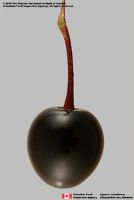 , berryberry:
, berryberry:
an indehiscent, fleshy fruit with one or a few to many seeds. The flesh may be homogenous throughout. Or, if the outer part is hard, firm, or leathery, referred to as an hesperidium. Septa are present in some, and the seeds may be arillate or with a fleshy testa.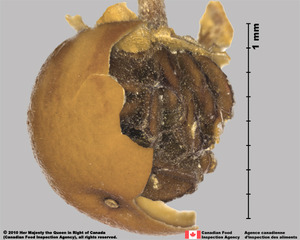 , samarasamara:
, samarasamara:
a winged, indehiscent, dry fruit containing a single (rarely two) seed(s)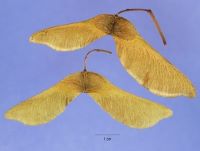 , or a circumscissilecircumscissile:
, or a circumscissilecircumscissile:
(~pyxis); type of capsular dehiscence, opens by a lid (splitting transversely)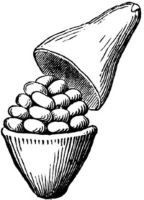 or loculicidalloculicidal:
or loculicidalloculicidal:
type of capsular dehiscence, opening longitudinally through the locules (compare septicidal)
 capsulecapsule:
capsulecapsule:
a dry, dehiscent fruit derived from a compound ovary , 3–100 mm long, globoseglobose:
, 3–100 mm long, globoseglobose:
3D shape—more or less spherical to angularangular:
to angularangular:
2D shape—having sides that meet at acute or obtuse angles
, usually tereteterete:
approximately circular in cross section; width and thickness approximately equal
 , sometimes compressedcompressed:
, sometimes compressedcompressed:
flattened; in grasses, used to denote compression (not necessarily flattened) either laterally or dorsiventrally
or flattened in transection, stylestyle:
in a flower, the narrow and elongated part of the pistil between the stigma and the ovary; sometimes persisting in fruit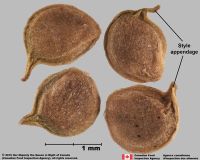 persistent, usually with one to four seeds drupesdrupe:
persistent, usually with one to four seeds drupesdrupe:
(indehiscent drupe) a fleshy, indehiscent fruit with one more hard pits enclosing seeds, derived from single, superior, simple or compound ovary; (dehiscent drupe) a fruit with a dry or fibrous to fleshy or leathery outer husk that early to tardily breaks apart (or opens), exposing one or more nutlike pits enclosing the seeds , berriesberry:
, berriesberry:
an indehiscent, fleshy fruit with one or a few to many seeds. The flesh may be homogenous throughout. Or, if the outer part is hard, firm, or leathery, referred to as an hesperidium. Septa are present in some, and the seeds may be arillate or with a fleshy testa. , samarassamara:
, samarassamara:
a winged, indehiscent, dry fruit containing a single (rarely two) seed(s) ) or with 4 to many seeds (capsulescapsule:
) or with 4 to many seeds (capsulescapsule:
a dry, dehiscent fruit derived from a compound ovary ). SamarasSamara:
). SamarasSamara:
a winged, indehiscent, dry fruit containing a single (rarely two) seed(s) with a wing encircling the fruit (Abeliophyllum, Fontanesia) or apically winged (Fraxinus). Pericarppericarp:
with a wing encircling the fruit (Abeliophyllum, Fontanesia) or apically winged (Fraxinus). Pericarppericarp:
fruit wall or fruit coat
variously colored, dulldull:
reflecting only a low proportion of incident light, with no apparent sheen , shinyshiny:
, shinyshiny:
uniformly reflecting a high proportion of incident light at all angles , or pruinose, membranousmembranous:
, or pruinose, membranousmembranous:
texture—extremely thin, pliable, and fairly tough
, chartaceouschartaceous:
papery, papyraceous
, or woodywoody:
texture—consisting mainly of indurate lignified tissues, characteristic of or resembling wood
capsulescapsule:
a dry, dehiscent fruit derived from a compound ovary , samarassamara:
, samarassamara:
a winged, indehiscent, dry fruit containing a single (rarely two) seed(s) ) or fleshy (including pulpy and spongyspongy:
) or fleshy (including pulpy and spongyspongy:
soft, light, discontinuous but cohesive, and somewhat resilient
) with thin, fibrousfibrous:
texture -- long, flexible threads, thicker than hairs, that densely cover and obscure the surface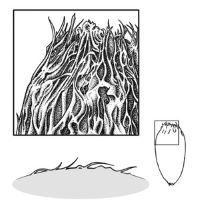 , bonybony:
, bonybony:
very hard and rather brittle, like bone
, or woodywoody:
texture—consisting mainly of indurate lignified tissues, characteristic of or resembling wood
endocarpendocarp:
the inner layer of the pericarp, if divided into layers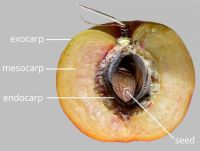 (drupesdrupe:
(drupesdrupe:
(indehiscent drupe) a fleshy, indehiscent fruit with one more hard pits enclosing seeds, derived from single, superior, simple or compound ovary; (dehiscent drupe) a fruit with a dry or fibrous to fleshy or leathery outer husk that early to tardily breaks apart (or opens), exposing one or more nutlike pits enclosing the seeds ), usually glabrousglabrous:
), usually glabrousglabrous:
without hairs
, sometimes pubescentpubescent:
surface relief—bearing hairs
or with red glandularglandular:
surface relief—covered with small, raised secretory glands, regular or irregularly shaped, translucent or opaque, and maybe distinctly colored dots, smooth or areolate, wrinkledwrinkled:
dots, smooth or areolate, wrinkledwrinkled:
surface relief—shallow, irregular folds and furrows covering the surface; appearing overall though crumpled and then spread out , wartywarty:
, wartywarty:
surface relief—distinct, rounded projections that are large relative to the fruit size; tuberculate, verrucose , ribbedribbed:
, ribbedribbed:
surface relief—wide, prominent, linear ridges that are generally rounded and longitudinally situated on the surface , lenticellate, or punctatepunctate:
, lenticellate, or punctatepunctate:
surface relief—dotted with pits or with translucent, sunken glands or with colored dots, similar to pitted (white dots).
(white dots).
Seeds globoseglobose:
3D shape—more or less spherical to oblongoblong:
to oblongoblong:
2D shape—much longer than broad with nearly parallel sides, corners are rounded , often flattened, 2–33 mm long, sometimes with large apicalapical:
, often flattened, 2–33 mm long, sometimes with large apicalapical:
at or pertaining to the end of the seed or fruit distal from its point of attachment (i.e., base)
wing (Comoranthus, Schrebera), medial wing (Fraxinus spp.), or narrow longitudinallongitudinal:
of or relating to length or the lengthwise dimension
wings (Frosythia spp., Syringa spp.). Seed coat black, brown, yellow, or red, leatheryleathery:
texture—moderately thick, tough, and very pliable
, glabrousglabrous:
without hairs
, smooth or veinedveined:
surface relief—lines that intersect in a vein pattern that is flush or slightly raised from the surface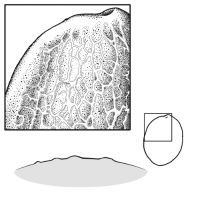 , or reticulatereticulate:
, or reticulatereticulate:
surface relief—netted, raised walls or concave grooves forming a net-like surface pattern with flat, concave, or convex interspaces .
.
Embryo well developed, completely to partially filling seed cavity, axileaxile:
on or of the axis
and centric, foliatefoliate:
appearing leaf-like
or linearlinear:
(shape) long, narrow, and uniform in width; (of embryo) embryo is straight and much longer than wide , straight, with spatulatespatulate:
, straight, with spatulatespatulate:
2D shape—like a spatula; rounded at the apex, with base long and tapered; (of embryo) embryo is straight and axile and centric with the cotyledons expanded to form the shape of a spatula or spoon; (of cotyledons) cotyledons expanded and wider than the stalk but not invested into the stalk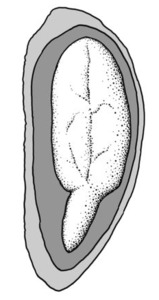 cotyledons.
cotyledons.
Endosperm copious or absent, if present fleshy, cartilaginouscartilaginous:
texture—firm, dense, tough, somewhat pliable, and resilient, like cartilage
, or bonybony:
very hard and rather brittle, like bone
.
| Fruit | |
| Type | drupedrupe: (indehiscent drupe) a fleshy, indehiscent fruit with one more hard pits enclosing seeds, derived from single, superior, simple or compound ovary; (dehiscent drupe) a fruit with a dry or fibrous to fleshy or leathery outer husk that early to tardily breaks apart (or opens), exposing one or more nutlike pits enclosing the seeds  , berryberry: , berryberry:an indehiscent, fleshy fruit with one or a few to many seeds. The flesh may be homogenous throughout. Or, if the outer part is hard, firm, or leathery, referred to as an hesperidium. Septa are present in some, and the seeds may be arillate or with a fleshy testa.  , samarasamara: , samarasamara:a winged, indehiscent, dry fruit containing a single (rarely two) seed(s)  , circumscissilecircumscissile: , circumscissilecircumscissile:(~pyxis); type of capsular dehiscence, opens by a lid (splitting transversely)  or loculicidalloculicidal: or loculicidalloculicidal:type of capsular dehiscence, opening longitudinally through the locules (compare septicidal)  capsulecapsule: capsulecapsule:a dry, dehiscent fruit derived from a compound ovary  |
| Size range | 3–100 mm long |
| Shape(s) | globoseglobose: 3D shape—more or less spherical  , bilobed, didymousdidymous: , bilobed, didymousdidymous:3D shape—paired, usually inflated and appears as two globose to ovoid halves pressed together , ellipsoidellipsoid: 3D shape—elliptic , ovoidovoid: 3D shape—ovate  , oblongoblong: , oblongoblong:2D shape—much longer than broad with nearly parallel sides, corners are rounded  , lanceolatelanceolate: , lanceolatelanceolate:2D shape—lance-shaped; much longer than wide, with widest point below the middle, tapering to the apex (compare oblanceolate) 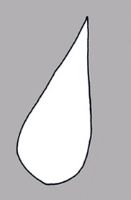 , pear-shaped, clavateclavate: , pear-shaped, clavateclavate:3D shape—club-shaped, with attachment at or near narrow end (compare obclavate) 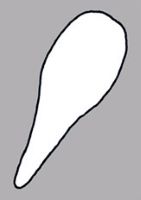 , falcatefalcate: , falcatefalcate:shaped like a scythe or sickle  , cylindricalcylindrical: , cylindricalcylindrical:3D shape—a cylinder, with parallel sides and a circular cross-section; tubular or rod-shaped , reniformreniform: 2D or 3D shape—kidney-shaped  , rhomboid, angularangular: , rhomboid, angularangular:2D shape—having sides that meet at acute or obtuse angles |
| Texture | capsulecapsule: a dry, dehiscent fruit derived from a compound ovary  , samarasamara: , samarasamara:a winged, indehiscent, dry fruit containing a single (rarely two) seed(s)  - membranousmembranous: - membranousmembranous:texture—extremely thin, pliable, and fairly tough , chartaceouschartaceous: papery, papyraceous , or woodywoody: texture—consisting mainly of indurate lignified tissues, characteristic of or resembling wood drupe - fleshy (including pulpy and spongyspongy: soft, light, discontinuous but cohesive, and somewhat resilient ) with thin, fibrousfibrous: texture -- long, flexible threads, thicker than hairs, that densely cover and obscure the surface  , bonybony: , bonybony:very hard and rather brittle, like bone , or woodywoody: texture—consisting mainly of indurate lignified tissues, characteristic of or resembling wood endocarpendocarp: the inner layer of the pericarp, if divided into layers  |
| Surface relief | smooth or areolate, wrinkledwrinkled: surface relief—shallow, irregular folds and furrows covering the surface; appearing overall though crumpled and then spread out  , wartywarty: , wartywarty:surface relief—distinct, rounded projections that are large relative to the fruit size; tuberculate, verrucose  , ribbedribbed: , ribbedribbed:surface relief—wide, prominent, linear ridges that are generally rounded and longitudinally situated on the surface  , lenticellate, or punctatepunctate: , lenticellate, or punctatepunctate:surface relief—dotted with pits or with translucent, sunken glands or with colored dots, similar to pitted  (white dots), usually glabrousglabrous: (white dots), usually glabrousglabrous:without hairs , sometimes pubescentpubescent: surface relief—bearing hairs or with red glandularglandular: surface relief—covered with small, raised secretory glands, regular or irregularly shaped, translucent or opaque, and maybe distinctly colored  dots dots |
| Color(s) | black, purple, green, blue, brown, orange, yellow, red, white, sometimes mottledmottled: with colored spots, streaks, or blotches of a different color 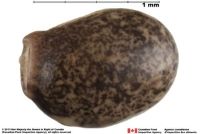 or spotted or spotted |
| Unique features | Usually 1- to 4-seeded berriesberry: an indehiscent, fleshy fruit with one or a few to many seeds. The flesh may be homogenous throughout. Or, if the outer part is hard, firm, or leathery, referred to as an hesperidium. Septa are present in some, and the seeds may be arillate or with a fleshy testa.  , drupesdrupe: , drupesdrupe:(indehiscent drupe) a fleshy, indehiscent fruit with one more hard pits enclosing seeds, derived from single, superior, simple or compound ovary; (dehiscent drupe) a fruit with a dry or fibrous to fleshy or leathery outer husk that early to tardily breaks apart (or opens), exposing one or more nutlike pits enclosing the seeds  , or samarassamara: , or samarassamara:a winged, indehiscent, dry fruit containing a single (rarely two) seed(s)  , sometimes circumscissilecircumscissile: , sometimes circumscissilecircumscissile:(~pyxis); type of capsular dehiscence, opens by a lid (splitting transversely)  or loculicidalloculicidal: or loculicidalloculicidal:type of capsular dehiscence, opening longitudinally through the locules (compare septicidal)  capsulescapsule: capsulescapsule:a dry, dehiscent fruit derived from a compound ovary  with numerous seeds. with numerous seeds. |
| Seed | |
| Size range | 2–33 mm long |
| Shape(s) | globoseglobose: 3D shape—more or less spherical  , ellipsoidellipsoid: , ellipsoidellipsoid:3D shape—elliptic , ovoidovoid: 3D shape—ovate  , oblongoblong: , oblongoblong:2D shape—much longer than broad with nearly parallel sides, corners are rounded  , often flattened , often flattened |
| Surface relief | smooth, reticulatereticulate: surface relief—netted, raised walls or concave grooves forming a net-like surface pattern with flat, concave, or convex interspaces  , veinedveined: , veinedveined:surface relief—lines that intersect in a vein pattern that is flush or slightly raised from the surface  , sometimes with apicalapical: , sometimes with apicalapical:at or pertaining to the end of the seed or fruit distal from its point of attachment (i.e., base) wing or longitudinallongitudinal: of or relating to length or the lengthwise dimension wings |
| Color(s) | black, brown, yellow, red |
| Other | |
| Embryo | well developed, completely to partially filling seed cavity, axileaxile: on or of the axis and centric, foliatefoliate: appearing leaf-like or linearlinear: (shape) long, narrow, and uniform in width; (of embryo) embryo is straight and much longer than wide  , straight, with spatulatespatulate: , straight, with spatulatespatulate:2D shape—like a spatula; rounded at the apex, with base long and tapered; (of embryo) embryo is straight and axile and centric with the cotyledons expanded to form the shape of a spatula or spoon; (of cotyledons) cotyledons expanded and wider than the stalk but not invested into the stalk  cotyledons cotyledons |
| Nutritive tissue | endosperm copious or absent, if present fleshy, cartilaginouscartilaginous: texture—firm, dense, tough, somewhat pliable, and resilient, like cartilage , or bonybony: very hard and rather brittle, like bone |
Nearly worldwide
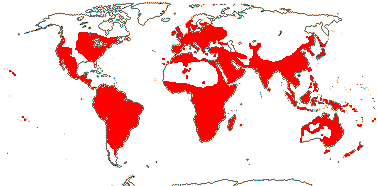
Distribution map courtesy of Angiosperm Phylogeny Website.
Davidse et al. 2009–2018Davidse et al. 2009–2018:
Davidse GM, Sousa Sánchez M, Knapp S. and Chiang Cabrera F, eds. 2009–2018. Flora Mesoamericana. Missouri Botanical Garden, St. Louis, MO. Accessed: January–April 2024. URL: http://legacy.tropicos.org/Project/FM; Fernández-Alonso and Morales Morales 2019Fernández-Alonso and Morales Morales 2019:
Fernández-Alonso JL and Morales Morales PA. 2019. Priogymnanthus colombianus (Oleaceae), a new species and first record of genus to Colombia. Phytotaxa 399: 195–202. https://doi.org/10.11646/phytotaxa.399.3.3; Flora of Australia 2021+Flora of Australia 2021+:
Flora of Australia. Australian Biological Resources Study, Canberra. Accessed January 2021–March 2024. URL: http://www.ausflora.org.au; Flora of North America Editorial Committee 1993+Flora of North America Editorial Committee 1993+:
Flora of North America Editorial Committee, eds. 1993+. Flora of North America North of Mexico [Online]. 22+ vols. Flora of North America Association, New York and Oxford. Accessed January-March 2024. URL: http://beta.floranorthamerica.org. (unpublished); Green 1963Green 1963:
Green PS. 1963. The genus Nestegis from New Zealand. Journal of the Arnold Arboretum 44(3): 377–389. http://www.jstor.org/stable/43781473; Green 2002Green 2002:
Green PS. 2002. A Revision of Olea L. (Oleaceae). Kew Bulletin 57(1): 91–140. https://doi.org/10.2307/4110824; Grimshaw and Bayton 2024Grimshaw and Bayton 2024:
Grimshaw J and Bayton R. 2024. Picconia azorica. Trees and Shrubs Online. URL: treesandshrubsonline.org/articles/picconia/picconia-azorica/. Accessed January 2024.; Hong 2016Hong 2016:
Hong-Wa C. 2016. A taxonomic revision of the genus Noronhia Stadtm. ex Thouars (Oleaceae) in Madagascar and the Comoro Islands. Boissiera 70: 7–291.; Hyde et al. 2021c+Hyde et al. 2021c+:
Hyde MA, Wursten BT, Ballings P, and Coates Palgrave M. 2021c+. Flora of Zimbabwe. Accessed January 2021–April 2024. URL: https://www.zimbabweflora.co.zw/index.php; Jongkind 2020Jongkind 2020:
Jongkind CCH. 2020. Two new Noronhia species (Oleaceae) from the Guineo-Congolian forests in Africa. Phytotaxa 433: 97–100. https://doi.org/10.11646/phytotaxa.433.2.2; Kiew 2020Kiew 2020:
Kiew R. 2020. Towards a flora of New Guinea: Oleaceae. Part 1. Jasminum, Ligustrum, Myxopyrum, and Olea. Reinwardtia 19: 1–25. 10.14203/reinwardtia.v19i1.3799. ; Kirkbride et al. 2006Kirkbride et al. 2006:
Kirkbride JH, Jr, Gunn CR, and Dallwitz MJ. 2006. Family guide for fruits and seeds, vers. 1.0. Accessed September 2020-January 2022. URL: https://nt.ars-grin.gov/seedsfruits/keys/frsdfam/index.cfm .; Kubitzki et al. 1990+Kubitzki et al. 1990+:
Kubitzki K et al., eds. 1990+. The families and genera of vascular plants. 7+ vols. Berlin etc.; Modak and Chowdhury 2021Modak and Chowdhury 2021:
Modak K and Chowdhury M. 2021. Morphological study of Nyctanthes arbor-tristis L. fruit and seed in different growth stages. Plant Science Today 8(4): 778–785. https://horizonepublishing.com/journals/index.php/PST/article/view/1174; Perrier 1952Perrier 1952:
Perrier H. 1952. Oléacées (Oleaceae). In: Humbert H. Flore de Madagascar et des Comores. Fam 166. 90 pp. https://www.biodiversitylibrary.org/page/9171359; PlantNET 2021+PlantNET 2021+:
PlantNET (The NSW Plant Information Network System). 2021+. Royal Botanic Gardens and Domain Trust, Sydney. Accessed January 2021–March 2024. URL: https://plantnet.rbgsyd.nsw.gov.au; Rakarcha et al. 2020Rakarcha et al. 2020:
Rakarcha S, Maknoi C, Tanming W, Thammarong W, and Panyadee P. 2020. Dimetra (Oleaceae), a new genus record for Lao PDR. Thai Forest Bullin (Botany) 48(2): 184–186. https://doi.org/10.20531/tfb.2020.48.2.09; Steyermark 1932Steyermark 1932:
Steyermark JA. 1932. A revision of the genus Menodora. Annals Missouri Botanical Garden 19: 87–177.https://www.biodiversitylibrary.org/page/16155969; Takhtajan 2009Takhtajan 2009:
Takhtajan A. 2009. Flowering plants: Second edition. Springer Nature, Switzerland. 871 pp.; Tropicos.org 2021+Tropicos.org 2021+:
Tropicos.org. 2021+. Pakistan Plant Database. Missouri Botanical Garden. Accessed January 2021–April 2024. http://legacy.tropicos.org/Project/Pakistan; Turland 1994Turland 1994:
Turland NJ. 1994. Oleaceae. In: Press JR and Short MJ, eds. Flora of Madeira. HMSO, London. pp. 255–257.; Turner 1991Turner 1991:
Turner BL. 1991. An overview of the north American species of Menodora (Oleaceae). Phytologia 71(5): 340–356. https://www.biodiversitylibrary.org/page/13167757; Tutin et al. 1964–1980Tutin et al. 1964–1980:
Tutin TG, Burges NA, Chater AO, Edmondson JR, Heywood VH, Moore DM, Valentine DH, Walters SM, and Webb DA (eds.) 1964–1980. Flora Europaea. 5 vols. Cambridge University Press, Cambridge UK. 2,524 pp.; Verdoorn 1956Verdoorn 1956:
Verdoorn IC. 1956. The Oleaceae of Southern Africa. Bothalia 6(3): 549–639. https://doi.org/10.4102/abc.v6i3.1707; Wallander 2022Wallander 2022:
Wallander E. 2022. Classification of the Oleaceae family. URL: https://www.oleaceae.info/oleaceae.html; World Flora Online 2024World Flora Online 2024:
World Flora Online. 2024. Noronhia Stadman ex Thouars. URL: http://www.worldfloraonline.org/taxon/wfo-4000026235. Accessed January 2024.; Zhengyi et al. 2004+Zhengyi et al. 2004+:
Zhengyi W, Raven PH, and Deyuan H. 2004+. Flora of China [online]. 25 vols. Science Press, Beijing China & Missouri Botanical Garden, St. Louis USA. Accessed January–March 2024. http://flora.huh.harvard.edu/china/; Zona 1991Zona 1991:
Zona S. 1991. A morphometric and taxonomic reevaluation of Haenianthus (Oleaceae). Canadian Journal Botany 69: 489–493. https://doi.org/10.1139/b91-066
*The number of genera and species is based on Christenhusz and Byng 2016Christenhusz and Byng 2016:
Christenhusz MJM and Byng JW. 2016. The number of known plant species in the world and its annual increase. Phytotaxa 261 (3): 201-217. https://doi.org/10.11646/phytotaxa.261.3.1, which may differ from the number of genera in GRIN-Global.